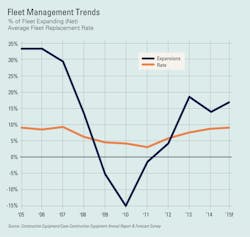Fleet Health Continues To Bounce Back
This year marks the first when all new engines used in construction equipment fleets must meet Tier 4-Final requirements. From here on, fleet managers will find new technologies on machines they acquire to replace those that have used up their useful life. In addition to emissions hardware, new machines will have sophisticated telematics capabilities, too.
As a result, new-machine prices are higher and maintenance strategies will need to be evaluated. Although the full impact has yet to be felt within most equipment fleets, today’s new machines promise to deliver better productivity, fuel-efficiency and safety than earlier versions.
More Annual Report & Forecast
Fleet managers will certainly have more financial decisions to make as they integrate the technologies into existing fleets.
The economy is strengthening, construction activity is growing, and fleet managers appear inclined to consider fleet replacement. Construction Equipment subscribers who responded to our 2014-15 Annual Report and Forecast questionnaire are more optimistic than in several years. Although continued dysfunction in D.C. and the lack of a long-term vision for transportation funding inevitably dampens the ability to plan, a sense of normalcy is returning.
Last year’s business year met expectations. Although any upward trend is good news—respondents labeled 2014 as “average”—the mood appears to be gaining postitive momentum. Even as economic and industry data are optimistic, the underlying distrust and uncertainty are dragging down robust and enthusiastic forecasts for this year.
Contract volume rebounded strongly in 2014, with forecasts for this year up even more. For the first time in several years, actual contract volume performance exceeded what was expected for 2014. Nearly half, or 47.9 percent, of respondents reported contract volume increases in 2014, and 16 percent reported decreases. For 2014 contract volume, the net (which is determined by subtracting the percentage reporting decreases from that reporting increases) is 31.9, far ahead of the expected net of 24.6. The percentage of those predicting contract volume growth in 2015 crosses over half, to 51.4 percent, and deducting the 14.4 who expect contraction in volume leaves a net of 37. Certainly, fleet managers see business continuing to rebound in 2015.
In tandem with contract volume are projected increases in bid prices. Some 55 percent expect pricing to increase this year, and 9.1 percent see reductions in bid prices; this leaves a net of 45.9. This also points to improvement in 2015 business conditions.
Fleet trends
Volume growth means newer machines and, maybe, more machines. Late in 2013, fleet managers expected to expand fleets with a net of 19.6 (29.4 percent expecting to increase minus 9.8 percent expecting to decrease fleet size). This expectation was not met, as actual fleet expansion netted at 13.8 (26.6 percent reported expansions and 12.8 percent declines). Perhaps as a result of the lack of expansion, the forecast for 2015 is only a slighty higher net of 16.8: About one-quarter (27.1 percent) expect to expand their fleet size minus 10.3 percent contracting.
Machine-replacement rates also fell short of what was expected for 2014, but the actual rate is inching closer to the traditionally healthy rate of 9 or 10 percent. The rate expected by fleet managers for 2014 was 9.4 percent; the actual fleet-replacement rate last year was 8.7 percent. Again drawing on the delay in fleet changes, managers are forecasting only a slightly higher rate for 2015: 8.8 percent.
Fleet health, which directly affects replacement rates, also inched up in 2014. About 40 percent of respondents said their fleets were in “very good” or “excellent” condition. In 2013, 37.3 percent reported similar fleet health. The percentage of fleets deemed unhealthy, either “fair” or “poor,” remained the same in 2014 as in the previous year: 15.5 percent. Those fleets unable to replace as quickly as needed will see fleet health stay low.
Rental continues as a viable acquisition strategy, with 18.5 percent using short-term rental and 17.5 percent using rental-purchase agreements. The benefits of having others manage emissions while freeing up cash continues to be an important strategy. On the other hand, an increase in purchasing occurred in 2014. More than half, 52.5 percent, reported purchasing outright, a number not seen in many years. Similarly, 39 percent reported purchasing by financing equipment.
Workforces grew for equipment managers, with 34.6 percent reporting increases in labor. Less than 20 percent reported decreases in their labor force, a net of 14.8 not seen for several years. Most of the growth occurred under “other hourly labor,” with “service and maintenance” and “operators” stable compared to recent years.
